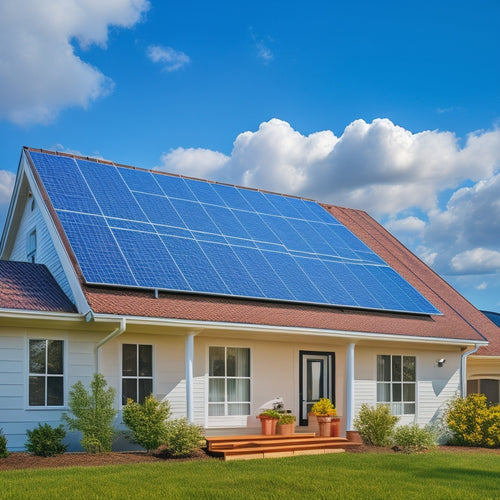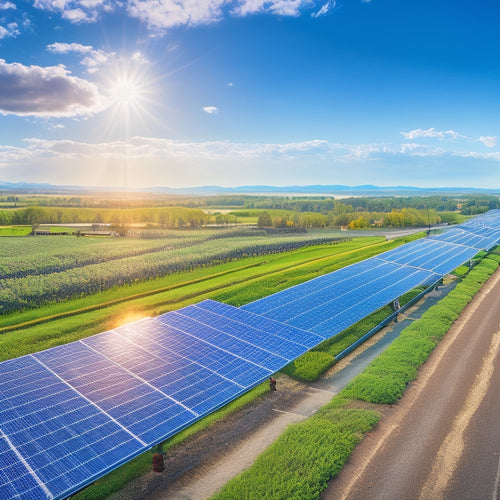
House Solar Power System
Share
With a house solar power system, you can reduce your carbon footprint and save money daily by utilizing the sun's abundant energy to power your home. By optimizing panel placement and selecting higher efficiency solar panels, you can maximize energy collection potential. Before installing, assess your roof's shading and obstruction patterns to guarantee effective solar panel placement. By doing so, you'll be able to generate more power, increase energy independence, and enjoy significant financial savings. As you consider making the switch, you'll want to investigate the finer details of solar system design and optimization to get the most out of your investment.
The Essentials
- Switching to solar power significantly reduces reliance on fossil fuels and lowers environmental impact, contributing to a cleaner and greener future.
- Solar power systems generate free energy, reducing reliance on the grid and leading to significant savings over time, with potential monthly savings ranging from $100 to $500.
- Optimizing panel placement and selecting higher efficiency solar panels maximize energy harvesting potential, enhancing energy production and independence.
- Assessing roof shading and obstruction patterns is crucial for effective solar panel placement, ensuring maximum sunlight exposure and energy generation.
- Utilizing high conversion rate panels and determining ideal solar panel orientation based on location and seasonal variations enhances energy generation and independence.
Reduce Carbon Footprint Now
You can markedly reduce your carbon footprint today by switching to a house solar power system that utilizes renewable energy sources.
By going green, you'll not only minimize your reliance on fossil fuels but also lower your energy bills.
With solar power, you'll be generating clean energy and contributing to a sustainable future.
Furthermore, a solar panel system tackles the uncertainty of energy price fluctuations, offering a reliable and long-term solution that protects you from volatile electricity rates, thereby ensuring a considerable return on investment and peace of mind for years to come.
Go Green Today
Go Green Today
Frequently, homeowners find themselves at a crossroads, evaluating the benefits of switching to renewable energy sources against the perceived costs and complexities of doing so.
You, too, may be considering the pros and cons of going green. The good news is that the decision to switch to solar power has never been more appealing.
Not only do you contribute to reducing the environmental impact of traditional energy sources, but you also stand to benefit from solar incentives.
Renewable Energy Sources
Renewable energy sources employ the power of nature to generate electricity, offering a cleaner alternative to fossil fuels. You're likely aware that fossil fuels have a considerable impact on the environment, contributing to climate change and air pollution. By switching to renewable energy sources, you can reduce your carbon footprint and play a role in preserving the planet for future generations.
With a reliable solar panel and battery kit off-grid solar systems, you can secure a backup power source during frequent outages and notably reduce energy bills by capturing the sun's rays to generate electricity.
Solar innovations have made it possible to capture the energy of the sun to power your home. With solar panels installed on your roof, you can generate electricity and reduce your reliance on the grid. Renewable incentives, such as tax credits and rebates, can help offset the initial cost of installation, making solar energy a more accessible option.
As you contemplate switching to renewable energy sources, you'll want to examine the options available to you. In addition to solar power, you may also want to think about wind, hydro, and geothermal energy.
Saves You Money Daily
You'll save money daily with a house solar power system, as it generates free energy from the sun, reducing your reliance on the grid.
By utilizing photovoltaic cells and efficient residential solar panels, you can maximize your energy production and minimize your energy costs.
This translates to lower energy bills, which can add up to significant savings over time.
Daily Energy Savings
Your house solar power system generates electricity daily, offsetting your reliance on the grid and reducing your energy expenditures. This means you're producing clean energy and decreasing your energy consumption from traditional sources.
By utilizing the power of solar technology, you're taking control of your energy needs and enjoying daily savings.
As your solar power system generates electricity, it feeds into your home's electrical panel, powering your appliances and devices. Any excess energy is stored in your battery or fed back into the grid, reducing your energy consumption from the utility company.
This translates to a decrease in your daily energy costs, putting more money back in your pocket.
With a house solar power system, you're not only reducing your energy expenditures but also your carbon footprint. You're producing clean, renewable energy, contributing to a more sustainable future.
Lower Your Bills
By offsetting your energy consumption with solar power, you're positioned to reap significant financial benefits. You'll be reducing your reliance on the grid and lowering your energy bills in the process. With a house solar power system, you can expect to save money daily, giving you more financial freedom to pursue your goals and dreams.
| Monthly Savings | Yearly Savings |
|---|---|
| $100 | $1,200 |
| $200 | $2,400 |
| $300 | $3,600 |
| $400 | $4,800 |
| $500 | $6,000 |
These savings can add up quickly, especially when combined with solar incentives offered by the government and utility companies. By investing in a house solar power system, you're not only reducing your energy bills but also increasing your energy independence. You'll be generating clean, renewable energy and reducing your carbon footprint, all while enjoying the financial benefits of solar power. With a house solar power system, you'll be well on your way to achieving energy independence and financial freedom.
Maximizes Energy Harvesting Potential
You can maximize your house solar power system's energy harvesting potential by optimizing panel placement to capture the most sunlight possible. This involves strategically positioning panels to minimize shading and adjust for seasonal changes in the sun's angle.
Optimize Panel Placement
Optimizing panel placement is crucial to maximize energy harvesting potential, as even slight misalignments can result in significant energy losses.
You'll want to evaluate the panel orientation, bearing in mind the direction your roof faces and the surrounding environment. Ideally, you'll want to install your panels facing directly at the sun's path, which varies depending on your location and time of year.
When determining the installation angle, you'll need to assess the latitude of your location and the time of year with the most sunlight. A general rule of thumb is to install panels at an angle equal to your latitude minus 15 degrees.
However, this can vary depending on your local climate and shading conditions. You may also want to contemplate adjusting the installation angle seasonally to optimize energy production.
Smart Energy Management
Thirty minutes of daily energy waste can be prevented with an efficient smart energy management system. This advanced technology optimizes your energy harvesting potential by streamlining energy production and consumption.
You'll benefit from real-time monitoring, which tracks your energy generation and usage, enabling you to make data-driven decisions. Smart energy management integrates with your energy storage system, ensuring that excess energy is stored for later use, reducing waste and lowering your energy bills.
Load management and energy analytics work in tandem to allocate energy efficiently, minimizing grid reliance. System automation enables seamless grid integration, allowing you to sell excess energy back to the grid.
With consumption forecasting and demand response, you'll be able to anticipate and adjust your energy usage, reducing peak demand and increasing energy efficiency.
Assess Your Roof's Shading
You'll need to analyze your roof's obstructions, such as chimneys, vents, and skylights, to determine how they impact your solar panel system's performance.
When considering off-grid energy solutions, it's crucial to evaluate the shading patterns on your roof, considering tree coverage, neighboring buildings, and roof features that cast shadows.
Roof Obstruction Analysis
Evaluating your roof's shading is an important step in determining the viability of a house solar power system. You'll need to conduct a thorough roof obstruction analysis to identify potential installation challenges. This involves evaluating your roof's angles, structural integrity, and material considerations to guarantee a secure and efficient solar panel installation.
Shading analysis is vital to determine the impact of obstructions on energy conversion. You'll need to take into account the effects of trees, chimneys, vents, and other roof features on your system's performance.
Maintenance accessibility is also essential, as you'll need to guarantee easy access to the solar panels for regular cleaning and maintenance.
Weather impacts, such as snow loads and high winds, must also be factored into your analysis. Additionally, you'll need to take into account aesthetic considerations, such as the visual appeal of the solar panels and how they'll integrate with your roof's design.
Shading Pattern Identification
Your roof's shading pattern is an important factor in determining the effectiveness of your house solar power system.
It's vital to identify the shading effects on your roof to optimize the performance of your solar panels. Shading can greatly reduce the energy output of your system, so it's imperative to conduct a thorough shadow analysis.
To assess your roof's shading, start by observing the roof's orientation and the surrounding environment.
Identify any obstacles that could cast shadows on the roof, such as trees, chimneys, or neighboring buildings.
Take note of the time of day and year when these shadows occur. You can use online tools or consult with a solar professional to create a detailed shading report.
Higher Efficiency Solar Panels
You can maximize your solar power system's energy output by selecting higher efficiency solar panels.
These panels are designed to convert a higher percentage of sunlight into electricity, resulting in more kilowatt-hours per hour of sunlight.
With higher efficiency panels, you'll generate more power per unit area, making the most of your roof's available space.
Maximum Energy Output
In conjunction with advances in photovoltaic technology, higher efficiency solar panels have emerged as a key factor in maximizing energy output from house solar power systems. You can enhance your system's energy production by selecting panels with high conversion rates. This, combined with ideal solar panel orientation, will guarantee you're utilizing the most energy possible from the sun.
When conducting an energy production analysis, you'll want to take into account factors like your location's irradiance levels, panel tilt, and azimuth. By analyzing these factors, you can determine the perfect orientation for your solar panels, which will vary depending on your location and the time of year.
For instance, a south-facing orientation is generally ideal in the northern hemisphere, but you may need to adjust this during the winter months to capture more energy. By fine-tuning your solar panel orientation and utilizing high-efficiency panels, you'll be able to generate more power and enjoy greater energy independence.
Frequently Asked Questions
Can I Install Solar Panels on My Old or Damaged Roof?
You can assess your roof's condition to determine if it's suitable for solar panels; if not, you'll need to repair or replace it before installation, as some installation options require a sturdy, damage-free roof to guarantee a safe and efficient setup.
Are House Solar Power Systems Secure From Cyberattacks?
You're right to worry that any connected device can be hacked; researchers have proven that cyberattacks on solar systems are possible, but you can rest assured that manufacturers implement strong cybersecurity measures to mitigate system vulnerabilities.
Will Solar Panels Affect My Home's Resale Value?
When you invest in solar, you'll likely enhance your home's resale value, as it's a desirable feature in today's property market trends, offering significant solar investment benefits that attract potential buyers seeking eco-friendly and cost-effective living solutions.
Can I Use Solar Power to Charge My Electric Vehicle?
Did you know 80% of EV owners charge at home? You can indeed use solar power to charge your electric vehicle, leveraging solar charging to fuel your freedom on the road, and potentially saving up to $500 annually on fuel costs.
Do Solar Panels Require Regular Maintenance and Cleaning?
You'll need to clean your solar panels regularly to maintain efficiency; aim for a cleaning frequency of every 6-12 months to guarantee ideal energy output, as neglecting maintenance can reduce the solar panel lifespan by up to 20%.
Final Thoughts
As you begin on utilizing the sun's energy, imagine planting a seed that grows into a tree of sustainability. Your house solar power system is that seed, blooming into a cleaner, greener future. With every ray of sunlight, it converts into savings in your pocket and a reduced carbon footprint. You're now a guardian of the planet, nurturing it for generations to come.
Related Posts
-

How to Achieve a Zero-Waste Lifestyle for a Greener Tomorrow
To achieve a zero-waste lifestyle, start by adopting the principles of refusing, reducing, reusing, and recycling. Sw...
-

Cost of Solar Panel Installation
You can expect to pay between $15,000 and $30,000 or more for a typical solar panel installation, depending on the sy...
-

Applications of Photovoltaic Systems
Photovoltaic systems are versatile, converting sunlight into electricity for various applications. You can use them i...


